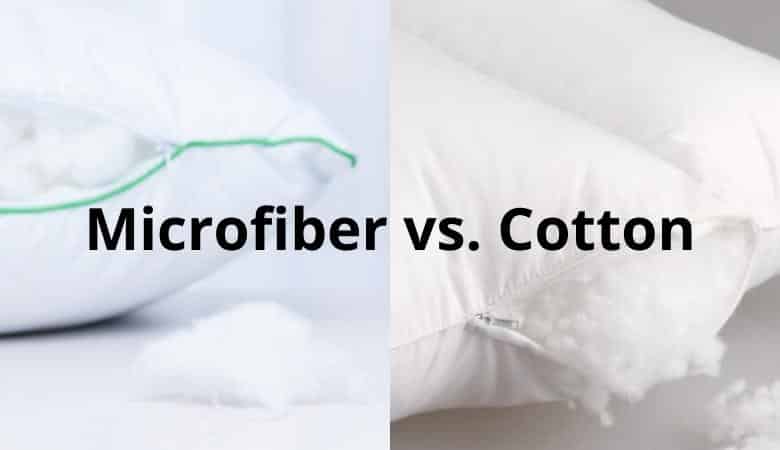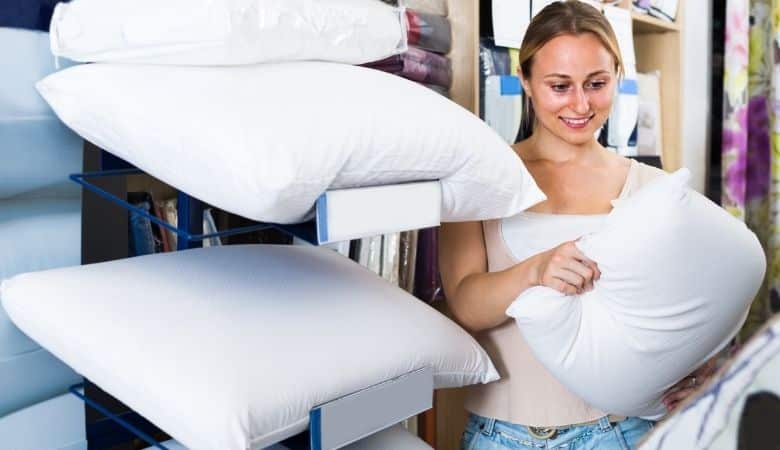This post is part of the complete cotton pillow buyers guide
Pillow shopping has never been as confusing as it is now, considering the different options available.
You have probably scratched your head a few times before deciding which pillow you will sleep on tonight.
Pillows are suitable for supporting our bodies when we sleep and also keeping our spine intact all through. For this reason, cotton and microfiber pillows are some of the most sought-after pillows, and due to their similarities, you are likely to get confused.
This guide will make things easy for you by breaking down the differences between these pillows to let you know which one works best for you.

Cotton vs. Microfiber: A quick comparison
Cotton pillows are more expensive compared to microfiber. Despite the price, cotton pillows are still some of the most preferred. They are all-natural, making them safe for use by people with allergic reactions or skin sensitivity issues.
Microfiber pillows can easily be termed as cotton’s distant cousin despite using different materials for their construction. These pillows look and feel like cotton, and if you cannot pay extra for a cotton pillow, pick a microfiber pillow and enjoy softness and comfort at a pocket-friendly budget.
If you are still torn between buying any of the two pillows, we will cover critical details about the two options to find which one is better and why. Keep reading and get educated.
Cotton Pillows
Cotton pillows are among the most popular natural and organic pillows besides buckwheat, wool, kapok, down and feather pillows. These pillows are filled with organic cotton fibers, which undergo high-standard planting and harvesting processes.
Cotton has been used to make pillows for a very long time, and they still remain popular in the market. The 100 percent cotton structure makes these pillows firm, supportive and comfortable. Regardless of the season, these pillows never lose their value.
The packaging of cotton material varies depending on the stiffness desired. Hence, these fillings can be lightly packed to give a soft cushion that is receptive to pressure and dramatically supports your head and neck.
Tightly packed cotton gives mid-soft to firm pillows which mostly keep your head and neck elevated to keep your spine in good shape. Due to their reliability, cotton pillows have been recommended for medical purposes.
Microfiber Pillows
Microfiber pillows are not to be confused with polyester pillows, but they are very similar. These pillows are made from synthetic fibers just like polyester, only that the grade of the threads differ. Microfiber is a polyester fiber that has been through an extra process to make the fiber finer and tightly packed than original polyester.
Microfiber pillows, therefore, look more like cotton pillows and are often confused for cotton considering many people cannot tell the difference between the two. Microfiber is inexpensive since they are produced mechanically. The materials are also available everywhere, meaning it serves various purposes at large.
Like cotton pillows, microfiber pillows have their own advantages and disadvantages. The pillows are soft, firm and breathable enough to keep the user cool all night.
During the production process, microfiber can be mixed with other materials like nylon which gives them a plastic feel, making them moisture resistant. Likewise, they are easy to maintain since you can toss them in a washing machine when it gets dirty.

Cotton vs. Microfiber Pillows: The Differences
1. Durability
While both pillows are comfortable and reliable for cool nights, their durability differs. Cotton pillows will last for a shorter time than microfiber if both are subjected to similar use conditions.
Cotton pillows are purely cotton-filled, and after sleeping on them for many months, the natural cotton tends to shrink and lose its fluff.
On the same note, microfiber pillows are filled with more delicate polyester fiber, giving them the advantage of withstanding all types of pressure. The materials can still maintain their loft and fluff even after using them past the expiry date.
2. Costs and availability

Microfiber pillows are usually compared to cotton pillows due to their similar functionality. Still, these two materials have different price tags on them.
Cotton pillows are becoming expensive by the day due to natural cotton being rare, and now there are strict manufacturing procedures to ensure safety. This means that you can only get cotton in a few bedding outlets at higher prices.
Meanwhile, microfiber, a form of synthetic fiber, tends to be inexpensive. Even though it is more expensive than other polyester forms, this pillow is the best alternative to cotton.
It is widely used in hotels and accommodation purposes. Synthetic fiber is readily available and less costly to produce.
3. Maintenance
Microfiber and cotton pillows are delicate and should be handled gently. However, the level of care and maintenance required differs between the two pillow materials.
Microfiber being a component of synthetic fiber means that it is compatible with machine washing and drying. On the same note, these pillows rarely lose their fluff when exposed to such cleaning conditions. The pillow is moisture repellent and can stay dry for more extended periods.
Cotton pillows on the other hand, are not safe around moisture, making water their number one enemy.
Even though cotton pillows are now machine washable and dryable, they tend to lose quality with every wash. This means that you cannot often wash your pillow throughout the year to avoid losing its functionality.
4. Breathability
Breathability is essential for people who sleep on their tummies. Cotton pillows are lightweight, and have air spaces between the fillings to make them more breathable. This is also good for keeping you cool since the airflow is well balanced.
Microfiber is equally breathable but traps heat efficiently. Compared to cotton, microfiber pillows are less breathable, which may be one driving factor for people who prefer cotton over microfiber. The closely packed mini polyester fibers can reduce airflow, thus affecting stomach sleepers.
5. Heat resistance
The essence of breathable pillows is to give cooling effects while you sleep. Microfiber pillows absorb body heat and become hot, which may be uncomfortable when used in hot areas or in hot seasons.
Nonetheless, many cold sleepers prefer them over cotton pillows. The worst part is if the pillow cover is polyester or microfiber. These covers tend to be soaked and become sticky with body fluids.
Cotton pillows can regulate their temperatures since cotton naturally allows better breathability. The cotton fillings also do not absorb body heat and fluids, making them the best for excellent sleeping. This advantage makes these pillows usable in all conditions.
6. Personal safety
The creation process of microfiber pillows is very complex. The synthetic fibers need to be converted into polyester, then taken through other processes that make the microfiber.
The final process may involve adding other materials like nylon and various chemicals. While they are generally hypoallergenic, people with sensitive skins tend to react to these materials when they sleep on them.
If you experience allergic reactions or have sensitive skin, you might want to use a different pillow for safety purposes.
Cotton pillows are natural and processed under safe conditions, which lowers the chances of reacting to them. They are also treated to have hypoallergenic properties and rarely absorb sweat, meaning that your skin stays safe.
Initially, the pillows do not have off-gassing like typical synthetic material pillows do.
7. Firmness

Microfiber pillows are made to closely perform like cotton pillows. You can expect these pillows to be firm and soft like cotton pillows.
When you first buy these pillows, they look fluffy and soft, and when you lay on them, they assume the shape of your head and neck for maximum support. After some time, microfiber usually stops being firm and becomes lumpy, which is uncomfortable.
Cotton pillows are initially very supportive yet soft at the same time. The loft and fluff of the pillow are long-lasting and adequately support your neck, shoulders, and head. Cotton pillows can also maintain their firmness over extended periods of use.

Cotton vs. Microfiber Pillows: Which one is better?
Microfiber pillows perform like cotton pillows and are the most used alternative to cotton. This proves that microfiber is a low-cost quality pillow with similar features.
Finding these pillows is also effortless since they are stocked in wholesale and retail stores dealing in beddings. If you are a cold sleeper, you will love how this pillow retains heat to keep you warm while being comfortable and supportive.
You can also clean the pillow frequently since it is machine washable and dryable. Their water retention is less than that of cotton, making them reliable.
Cotton pillows are top-tier luxury beddings, and many people prefer them for their appeal and exclusivity. While microfiber is a cheaper alternative, people still pay for expensive cotton pillows without batting an eye.
These pillows are safe, with no chemicals used in the manufacturing process. Cotton can also last longer, meaning you do not have to worry about a replacement before its expiry date.
This pillow works for various sleepers due to its cooling, heat resistant, and moisture repellant properties.
The bottom line is that microfiber pillows are better because they are affordable, available, and still carry the most essential properties of cotton pillows. Buying microfiber pillows save you time and money while giving you the freedom to maintain your beddings as you wish.
Conclusion
So far, so good; we have covered some of the main details differentiating the two pillows. You can quickly identify what type of pillow meets your sleep requirements using this information.
While focusing on softness, loft, fluff, size, and comfort, you need to consider your budget. Do not go beyond what you can afford, yet you can pick the alternative that still serves the same purpose.
Next time you buy pillows, use this guide as a checklist to be sure you are taking home a worthy pillow.
FAQs About Cotton And Microfiber Pillows
Is microfiber safe?
Yes! Microfiber is also synthetic fiber, and numerous questions surround microfiber’s safety. Even though the end products of microfiber are safe for use, concerns revolve around the manufacturing process of the pillows.
Microfiber is basically a plastic component, meaning it has petroleum and chemical qualities that contribute to its form. While the raw materials are considered toxic in their pure form, the manufacturers ensure they reduce the toxicity in every process to ensure the end product is free of toxins and heavy metals.
Before the pillows are sent into the market, they undergo a treatment process to make them safe. Therefore, you should worry less about the safety of the pillow because it must be approved and certified before selling.
Can you use a washing machine to clean cotton and microfiber pillows?
Yes, you can. Both pillow materials are machine washable, but you need to be cautious before starting any cleaning process. First, you need to read the pillow tag for the manufacturer’s instructions about machine washing. Your pillows must be washed moderately to avoid ruining the firmness and loft.
Microfiber pillows are moisture-resistant, making them easy to wash and dry. After you take them out of the washing machine, you can place them in the dryer at low heat to remove any remaining moisture.
On the other hand, cotton pillows will disappoint you with their high water retention rate. They take time to dry unless taken out in the sun. If you have to dry them in a dryer, you need to be careful about the heat to avoid burning your cotton to produce an awful smell. You will also have to fluff your pillow to regain its structure.
Which pillow is the best for hot sleepers, cotton or microfiber?
Cotton pillows are the best for hot sleepers. These pillows have moisture-wicking components that serve hot sleepers who sweat profusely through the night. These pillows are also breathable making them sufficiently circulate air and avert heat retention.
The pillow’s surface will be cool with regulated temperatures to provide a conducive sleeping surface. While microfiber pillows are also breathable, they are not good at dissipating heat and mostly retain all the heat from your body. Therefore, you will sweat more when using this pillow, and you might get sticky. Before choosing either of the two, you need to understand your sleeping needs.
Cotton Pillows: A Complete Buyers Guide – Parts:
1. Why Use a Cotton Pillow? The Benefits & Drawbacks
2. Cotton vs. Microfiber Pillows: Differences, And is One Better?
3. How Long do Cotton Pillows Last? This is The Replacement Time
4. Why Do Cotton Pillows Get Lumpy? How to “Unlump” Your Pillow
5. Do Cotton Pillows Flatten Over Time? How to Fluff a Pillow
6. Best Cotton Pillows of 2022 – Complete Review
7. How to Wash And Dry a Cotton Pillow: Step by Step


